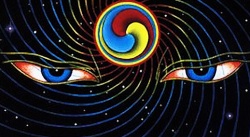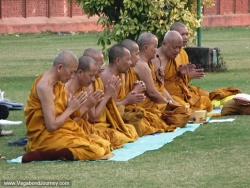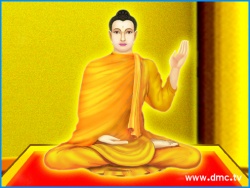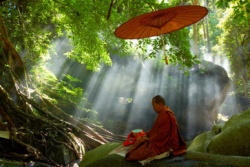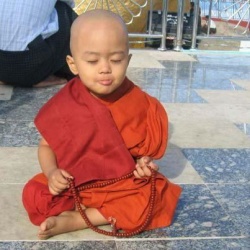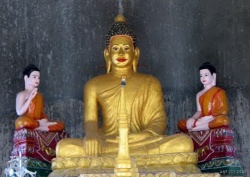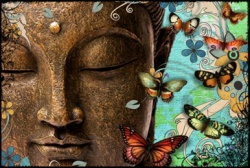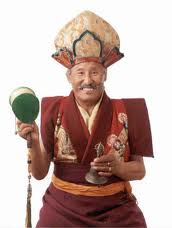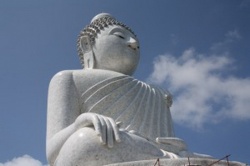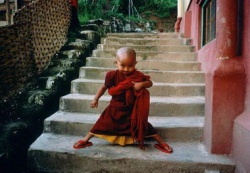Vajrayana and the significance of the Empowerment
by Yongey Mingyur Dorje Rinpoche at
Kagyu Samye Ling, August 2003. Translator Chödrak
The teachings this morning are going to be an introduction to the Vajrayana and also an explanation of the significance of the Empowerment in Vajrayana tradition. Within Tibetan Buddhism we normally describe what are called the three Vehicles or the Three Paths. These three different vehicles are the Hinayana Path, The Mahayana Path and the Secret Mantra - Vajrayana Path. The day before yesterday I gave you an example. The example was - if you remember - three different ways of coming from London to Samye Ling; by walking, in a motorcar or in a plane. In Tibetan Buddhism we think that the Hinayana Path is rather like somebody walking to a destination. The Mahayana Path is rather like driving a car. The view of the Secret Mantra Vajrayana is rather like an airplane. So which one do you like best? If you walk you get more exercise!
Generally speaking we are presented with many options in our life, but this time we don't have to worry about which one to take. Nowadays in the modern world if we are not able to have the choice we want or we can't always decide what we want, then we worry, because we can't decide which thing to do. There are so many options. This time you do not have to worry, because you can practise all three! You can do whatever is easiest for you.
If you think, "Well, there are these three types of vehicles, which am I going to practise, maybe it's going to be difficult for me." You don't have to worry. You might be worried that there isn't just one path to practise but there are three altogether. You don't have to have this kind of worry. Actually having the choice of three vehicles makes it all easier, because you don't have to just stick with one, which might be difficult for you. You have a choice of three. As a practitioner you don't have to make a choice between the three vehicles, one does a union of all three together.
In the morning you are doing Tara practice, aren't you? For those who do, in the beginning of Tara practice there is refuge. That contains the Hinayana type of practice. Also the refuge recitation has the recitation of bodhicitta, so that's the Mahayana aspect. Further on in the practice there is the front visualization and also visualizing oneself as the deity. This is to do with the development stage of the Secret Mantra Vajrayana. That's the meaning of the development stage. When you finish the practice and the deity dissolves into oneself, and one's mind and the deity's mind are inseparable, that's the completion stage. Because there is the union of these three paths, three options, it becomes very easy to practise. That was the explanation of the differences between different yanas.
If you want to divide the three paths into two, we can put Hinayana and Mahayana together and that will be sutra. You have one left, Secret Mantra Vajarayana and that belongs to the classification of tantra. Generally speaking, with the teachings of Hinayana and Mahayana, which belong to the sutra, one practises with the cause. What does that mean? Enlightenment, which the Buddha has, is the cause of practice. First we are practising fully the result of the wisdom and enlightenment of the Buddha, that is the purpose of the path. The tantra path is called the Path of Fruition. Why is that different, why is it called the Path of Fruition? It is because all the qualities, enlightenment and wisdom which the Buddha possesses, we also have at this moment. Yesterday I said that the wisdom and the enlightenment that the Buddha has, we have the same. Within this practice of the path, which is practising the fruition, it is like visualizing oneself in the development stage as a deity. For example "I am Dorje Sempa, all the qualities and wisdom which Dorje Sempa possesses, I also possess. This is an example of practising the path of fruition.
In the sutra tradition, which is the path of the cause, we do not have a direct method of realizing Buddha nature or enlightenment, because this depends on the experience of total understanding of emptiness and bodhicitta. That is not within the sutra. Within the tantra path, the path of fruition, we have a direct method with which we can realize our nature of mind through emptiness and bodhicitta. Those are basically the differences between the sutra path and the tantra path.
Within the Secret Mantra Vajrayana path there are two divisions. The first one is the path of skilful means and the second is the path of liberation. If we explain further what the path of skilful means is, there are various methods through which to realize directly our nature of mind. It is revealed to us through these various types of practice. With skilful means we go indirectly to realize the nature of mind, we don't come directly to that realization. In the sutra tradition they don't have these skilful means. They don't have such methods as visualizing oneself as a deity: I am Dorje Sempa or another deity; they don't have that type of skilful means. Their point of view rather is that the deity and you are separate, the deity is above you and you are down below and you are supplicating to the deities. So there is a big difference: there is a higher and a lower.
Within the skilful means there are also two divisions: the development stage and the completion stage. What does the development stage mean? It means to realize the wisdom of the Buddha and to practise visualizing ourselves as a deity, the buddha body relates to the visualization of the physical form of the deity one is practising. The speech aspect is the mantra recitation. The mind aspect is to do with visualizing in the heart centre various objects. Sometimes it's a letter: hung or hri, it can be a Dorje and so on. These aspects together define the development stage practice. The wisdom of the Buddha has no shape or colour, however, we practise with shape and colour.
Some people like this method. If people feel positive towards this type of practise, then they should do that. But some people don't like that kind of practice. For people who don't feel drawn to this type of practice, they shouldn't do it too strongly, just a little bit. That's the explanation of the development stage.
What does completion stage mean? Within our mind we have wisdom and awareness the same as a Buddha, and our body is also the same as the buddha body. When we are practising the completion stage we have the idea that our body is the wisdom aspect of the Buddha. Then we practise with the body, we train with the body physically. Having trained physically, the channels and the wind energy and the essence which travels around in the channels are slowly transformed. Because our physical nature is transformed, our mind also becomes transformed. The main point is practising with one's body. So then, if one is training with the wisdom wind which moves through the channels and the precious drops, then one adopts the posture and holds the vase breath and does the trulkor or the yoga practice and it's very physical. When one gradually over time purifies the impure winds, impure channels and impure drops, then all of one's defilements and obscurations are purified. One will naturally give rise to recognition of the nature of mind. That's the explanation of the completion stage.
Now we have the second aspect of the Vajrayana which is the path of liberation. When we practise the path of liberation, we have a direct method to realize the nature of mind, but there is no shape or colour for that. This is the mahamudra. We all possess what is called Buddha nature. All beings have it, people have it and also animals have it. All beings within the six realms of existence possess Buddha nature. westerners have it and easterners have it. Fat people have it, thin people have it. People who follow a religious path, they have it and people who don't, they also have Buddha nature. So we have to realize that we possess Buddha nature. We don't have to have an image of it; we just realize that we possess this. We don't have to feel at that point: I am the deity, I am Dorje Sempa. One doesn't think like that. There is no image for the nature of one's mind, Buddha nature. No image goes along with that. You don't have to do like you do on the path of skilful means: holding the breath for a long time and then doing the trulkor, which is physical yoga. One doesn't need to get tired out doing that kind of thing. With this direct approach in the mind one doesn't base it on the body, the physical, so much. It is based within the mind itself. Then one has a relaxed body.
Generally speaking we can say it is very, very easy to do this. Everybody can. You don't have to visualize it or meditate about it. You don't have to practise it; you don't have to abandon it. You just have to have recognition. Easy, isn't it! But, why it's difficult is because it's so easy, too easy. Because it is so easy you think: "Can't be like that, I can't have confidence in that, I don't believe it. [Rinpoche says in English:] It's nothing special. I need meditation! Relaxation, clarity: oh, this is nature of mind, now I see it! [Translator:] So, some people think they have to do that, as just described: stay relaxed when one is not relaxed. [Rinpoche:] Peaceful!! (Laughter)
The Vajrayana path can be divided into three sections. There is the development stage, completion stage and path of liberation (kyerim, dzogrim and drollam). Within these three paths one can decide whatever one likes to do, whatever one is feeling positive towards. But the best actually is the path of liberation. Practising the development stage, one can quickly get to the completion stage; and based on practising the completion stage, one can get quickly to the path of liberation. Do you have any questions?
Q: Can many methods be used simultaneously?
R: Whatever you like and feel positive towards. The final result of all of the different methods is the same. Because the end result is the same, one is allowed to change and alternate the methods. For example: this watch is the level of enlightenment and I am a long distance away. Then I need to practise a path of meditation, one method. So I get that far. If one becomes bored with that practice, and there is no clarity in it, then one is obstructed at that point, and cannot go any further. If you change your method, you can go a little bit further. Then if you get blocked at that point and it's boring again, then you try another method. You go very slowly, bit by bit, changing the methods. But what it means is - you get closer and closer to your goal. One might think: "Well, I'm practising shine meditation", but then it becomes quite boring, you come to a block. So you think: "Now I am going to practise development stage." One doesn't need to think: "I'm practising the development stage; maybe the shine is going to be harmful for that." It is not - actually shine is very beneficial for the practice of development stage.
Q: Is the path of liberation rather like mindfulness?
R: Actually, when you are practising the path of liberation, it is kind of directly introducing one to the nature of one's mind, but one starts out by practising shine. With the practice of shine you definitely need to have mindfulness. If you can realize the essence of your mind, sometimes you could put a label to it and say: "This is mindfulness." But the mindfulness at this point has no subject or object. It is just labelling something "mindfulness".
Q: Regarding liberation and recognition, when you are doing the practice, can you focus more on the lhaktong aspect?
R: The recognition is lhaktong. Lhaktong means clear seeing.
Q: It still has stages related to visualization.
R: How is it different? What does lhaktong mean for you?
Q: Almost like identified with the clear light..
R: What kind of clear light? Is it like sunlight or like electric light? Does it have a colour?
Q: No.
R: Where does it come from?
Q: That's the question I had.
R: That is the real question then. You have to ask yourself: "Where is this light coming from?" You said that when you are doing lhaktong, you have this light and you also have the questions. So, what kind of questions? Not all of the methods you described are lhaktong. With lhaktong one doesn't need to think anything about light. And if there are many questions, that's not particularly good. In the beginning, when one starts to practise lhaktong, a few questions are okay, but then later on, one doesn't have to have questions. Just have recognition.
Q: Rinpoche, you said it is good to change practices if you get stuck, to go further, but it is also said we always want to change, it would be better to stick with one. So how do you know when it is good to change and when it is good to stick with one practice?
R: The answer is related to using the development stage as an example. You are practising a deity and you have a visualization of a deity. Within the practice time sometimes one is visualizing or concentrating on the form of the deity and we can change that to concentrating on the recitation of the mantra. Then again, you can change that to resting on the nature of mind. Other times we can just relax. Within that technique of following a single practice with one deity, there are many changes that you can make. But it is not being suggested, that if you get a bit bored, you just throw away the development stage practice and yidam practice altogether. That is not being suggested here, but within one practice you can change the technique or focus.
To illustrate the difference between sutra and tantra, here is an example. There is a man who is carrying stones. The man is walking along and he throws his stones at a dog he sees. He also sees a lion and he throws his stones at the lion. So what does the dog do? When he threw the stone at the dog, immediately the dog tried to bite the stone or chase it. The man throws another stone at the dog. The dog tries to follow the new stone and bite it. This guy has got a big pile of stones, so his stones are not going to finish any time soon. The dog becomes very tired. Then he throws one stone at the lion. The lion won't look at the stone. He looks: "Where did that stone come from? Who threw that stone?" He sees the person who threw the stone and jumps on him. So then he can only throw one stone.
It's said that when one practises the sutra path, which we already said was the Hinayana and Mahayana path, it takes three limitless kalpas to arrive at the state of complete enlightenment. So it is quite a slow path. But the Secret Mantra Vajrayana path is rather like the lion immediately recognizing where the stone is coming from, we are working and practising with recognition of one's natural state, the nature of one's mind. Based on that, one can swiftly come to the level of complete enlightenment. It is said that in one lifetime, one body, one can reach enlightenment. That's using an example. Our practice within the Vajrayana is based on the emptiness of phenomena and compassion. Based on these two and using skilful methods one can swiftly reach the level of enlightenment. That's the explanation of the Vajrayana.
Empowerment
Within the Vajrayana teachings the giving of empowerments is a particularly special thing. The empowerment is like a seed planted on the path. This seed bears fruit and that's the result of our practice. The seed, which bears the fruit on the path of fruition, which is the path of Vajrayana, is the empowerment.
In a field, if we want to grow something, whatever it is, we need to put a seed in the ground first. We actually possess all of the qualities of a Buddha and we have Buddha nature, but we don't recognize it. From beginningless time we have been travelling in samsara and the reason for that is because we haven't practised successfully so far. The seed, which is on the path, it can be likened to an empowerment.
We have two things: the wang (empowerment) which brings fruition and the liberating instructions. And the lung is the scriptural authority, a companion or friend on the path. The Buddha Sakyamuni practised for three immeasurable kalpas following the sutra path and then, when he came to Bodhgaya, all the Buddhas of the three times gave him an empowerment of light. After receiving that he was placed on the path of Vajrayana. Then very swiftly he became enlightened and then he taught.
So, what is the foundation or cause of all of these things coming about - complete enlightenment and realization of the nature of mind - it all depends on the basis, which is the nature of one's mind, one's Buddha nature.
There are four points that relate to purification. We can use the example of a big lump of crystal obscured by mud. The crystal is what we call an object. The mud, which is obscuring the crystal, is what is to be purified, and the method of purifying or cleaning away the mud is soap and water. The result of these three is the complete cleansing of the crystal and its true nature is revealed. The object - the crystal - if we relate that back to ourselves, our crystal is our Buddha nature. What is our mud which obscures our crystal? Our Buddha nature is obscured by illusions. The illusions cover everything. They include impure body, impure speech, impure mind and the impure external perceptions. The purification process is our path of practice. There are two paths: the sutra path and the Vajrayana path. The fruition of cleansing is complete enlightenment. If you understand this, you understand everything.
Dorje Sempa empowerment
Now follows a brief explanation specifically about the Dorje Sempa empowerment which you will receive this afternoon. Generally speaking there are many types of Buddhas. We can say there are a hundred types of Buddhas and also they can be divided into seven types and twenty one types. But if one brings them all into the smallest division it will be five types or the five Buddha Families. If you want you can reduce that into one, it will be Dorje Sempa. Dorje Sempa is actually the union of all of the different types of Buddhas.
If you want to understand what Dorje Sempa looks like, he has a white body, he holds a dorje in his right hand at the heart and a silver bell on his knee. If you were to look at him, that's how he appears to you. But that's what we call the visualised shape. The real meaning of Dorje Sempa is one's own nature of mind. If you want to perceive that externally, then he appears as described. Basing our practice on the external Dorje Sempa, our internal Dorje Sempa will be purified. Within the Vajrayana practice, the empowerment of Dorje Sempa is considered extremely important. The empowerment I give you this afternoon is a very brief empowerment. There is not very much in it, but the meaning is very good.
So there are four types of empowerment. There is the vase empowerment, secret empowerment, wisdom-knowledge empowerment and the word empowerment or mahamudra empowerment. What's the reason for having four types of empowerment? To remove the body's impurities and defilements and to purify and liberate oneself from physical illusions one needs the empowerment of the vase. So when one has received this empowerment of the body and purified all the bodily illusions, one is empowered to practise the development stage.
The secret empowerment relates to speech and this purifies all the illusions of speech. Within the body there are many types of wind. Based on the wind is speech. Having received the secret empowerment which is related to speech and the winds, one is empowered to practise what they call channel and wind and secret drop practices, such as trulkor and breathing exercises and so on. So we can do the vase breathing as demonstrated.
The wisdom empowerment is related to the mind, and this purifies the obscurations and illusions of mind. One is empowered to do the practice of bliss and emptiness.
The fourth empowerment is that of the word or mahamudra. It's like talking or pointing out instructions with the words. But the meaning is mahamudra. So then one practises with the essence of one's mind. This is the complete removal of all of the mental illusions. So there are these four types of empowerments. If you want to reduce all the empowerments into just one, it will be the last one, which is the word or mahamudra empowerment. That's finished.
So I'm going to tell you a little story. It's about empowerments. In India there was a great siddha. This great siddha or yogi was able to fly in the sky and walk through walls. One day the siddha went to town and met the king. The king said to the yogi, "Who are you?" He said: "I'm a great yogi." "If that's the case, you must have a method to become immortal. Could you give me this method of freeing oneself from death?" Yogi said: "Yes, fine." "How are you going to do it?" "Bring me a bumpa (vase)." He brought a big vase. Inside the vase was empty. He said to the king, "Now you look at that vase very closely." Then the yogi put his hand inside the vase and pulled his hand out. He said: "Inside, here is something: emptiness! That's the method to avoid death." The king thought: "There is no meaning to that; maybe he is trying to fool me." So he put the yogi in prison. He made the yogi stay in jail for six months.
Six months later the many students of the yogi, quite clever themselves, thought: "Where has our teacher gone?" With their clairvoyance they realized he was in jail. They all got a bit annoyed and jumped up into the sky and started flying all over the place. "We are going to get our teacher." They were all in space above the king's palace, flying around. The king saw them. "They must be great yogis." He lit lots of incense and said: "Please come down." They all flew down in front of the king. The king with great devotion said, "Please give me a method for avoiding death." They agreed. They made a very big mandala. On top of it they made a sand mandala. On top of this they placed many parasols and victory banners and many types of various offerings. They made it very beautiful. The king saw this preparation and how nice it all was and he thought: "Wow, I'm really going to get the method of avoiding death this time. Just look at that!" The yogis all gave an empowerment in a very beautiful way, very nice. They gave the vase empowerment, the secret empowerment, the wisdom-knowledge empowerment. Then they said to him, "Now, the fourth empowerment is the most important one. The true method of avoiding death is this fourth empowerment. So, now I'm going to give it to you. Give me a vase." The king came and offered a big vase. They said to the king, "Now you watch that vase really well." One of the yogis put his hand inside the vase. Then he said: "Inside in my hand is something: it's emptiness. That's it." The king said: "Oh, that method is such an important method, I didn't realize before. This yogi six months ago, he gave me the same thing. I threw him in a jail." "I think that's a bit of a mistake." "What can I do now?" "Go and get him out of the jail and bring him here."
He brought the yogi, who had been in prison for six months, before the king. The king asked the yogi: "What was the meaning of the contents of the vase, you tried to tell me? First he said: "The vase was a round shape, wasn't it?" Within that was a sphere of space, I put my hand in and pulled it out. It was empty. The emptiness has no birth or death. Within the vase is emptiness but the external appearance is of a vase. That's clarity. So then, the union of the two, the external appearance of the vase, which is clarity, and the internal emptiness, is the union of appearance and emptiness. And your nature of mind is like that. So then the king realized the meaning. Then the king made many apologies and confessions to the yogi. The yogi said to the king, "You don't need to make any confession to me, because I have had six months in jail, and because of my previous karma I had to go to jail. Then the king turned around to all the students of the great yogi and said: "You have done very well, you made a very beautiful mandala and you gave me an empowerment, but actually the real empowerment came from the yogi from before." That's the end of the story.
Q: You gave the example of three different ways to reach Samye Ling from London. If I take a plane, I won't see the views. If I walk I will see the scenery and it will be a more direct experience. Are we lacking something if we go very quickly?
R: You can put it like that, yes. But the final result is the same; you all end up in Samye Ling. When you get to the final result, which is total enlightenment, you become omniscient, you know everything. All experiences are contained within that.
Regarding the sutra path and the tantra path, the sutra path is very slow and you gradually go higher and higher through the various levels. When one reaches the first bhumi or the first level in the sutra path, that gives rise to many qualities in one's mind. In the Vajrayana path one is introduced to the nature of mind very quickly, but regarding the qualities and having some experience of the nature of mind at that beginning point, then externally looking at it, the sutra experience of first bhumi is a little bit more than the tantric experience.
For example what one can do on the first bhumi level is that one can multiply one's body a hundred times. In the vajrayanan way, when one reaches the first level, one is not able to emanate oneself in a hundred bodies. There is a difference. But the final result of both sutra and tantra is buddhahood, enlightenment. There is no difference.
